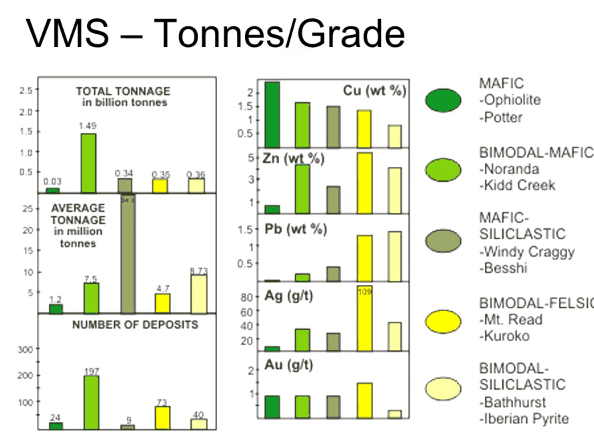
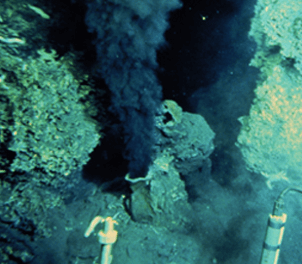 If we start with VMS Volcanogenic Massive Sulphide Ore Deposits and their Mineralization we see from this image shows some of the sulphide chimneys associated with the model black smoker VMS deposit.
If we start with VMS Volcanogenic Massive Sulphide Ore Deposits and their Mineralization we see from this image shows some of the sulphide chimneys associated with the model black smoker VMS deposit.
VMS will emit black plume of hot water venting from one of the chimneys. 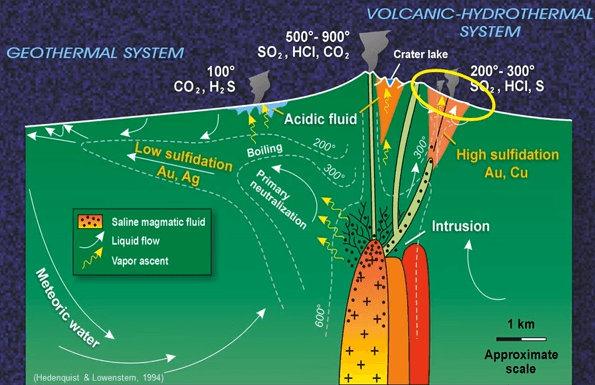 You’ll remember this cross section from reads on both porphyry deposits and epithermal, in the case of VMS deposit, we are basically looking at a submarine high sulfidation epithermal deposit venting from an underlying hot chamber into the sea.
You’ll remember this cross section from reads on both porphyry deposits and epithermal, in the case of VMS deposit, we are basically looking at a submarine high sulfidation epithermal deposit venting from an underlying hot chamber into the sea.
VMS deposits are dominated by copper and zinc, but there are a number of other minor minerals, including: lead, silver, gold, cobalt, tin, selenium, magnesium, cadmium and a whole host of other ones that are associated with them.
The deposits consist of a massive sulphide cap that formed on the seafloor and sort of lies parallel between two stratigraphy and an underlying feeder zone or streamer zone as it is usually called. 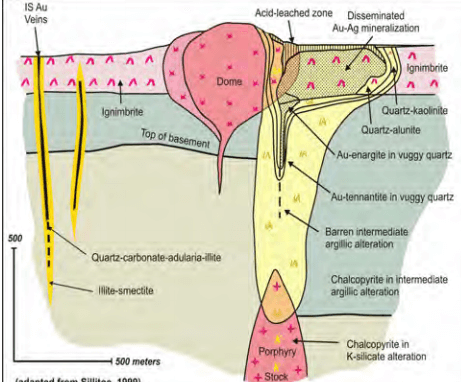 VMS is basically mushroom shaped, Streamer zone tends to be copper rather than zinc rich. VMS deposits often form as clusters over a large intrusive heat source. If the heat chamber is long-lived you may get flat lenses of massive sulphide, each fed from the same fault, beginning successively younger as you go up through the stratigraphy. The deposits are pretty common although, as with any deposit type. There are only a few big enough or high enough grade to be economic. In spite of that, they really are economically significant with 27% of Canada’s copper production and almost 50% of its historical zinc production, and 20% of the Pb having come from this group of deposits.
VMS is basically mushroom shaped, Streamer zone tends to be copper rather than zinc rich. VMS deposits often form as clusters over a large intrusive heat source. If the heat chamber is long-lived you may get flat lenses of massive sulphide, each fed from the same fault, beginning successively younger as you go up through the stratigraphy. The deposits are pretty common although, as with any deposit type. There are only a few big enough or high enough grade to be economic. In spite of that, they really are economically significant with 27% of Canada’s copper production and almost 50% of its historical zinc production, and 20% of the Pb having come from this group of deposits.
VMS deposits have been forming throughout geological history and they still are forming on the seafloor today. Here’s a bunch of the better-known deposits you may have heard of. 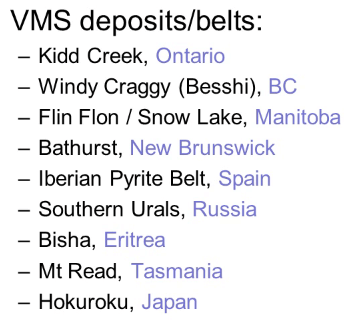 As you can see they are scattered all around the world, but I’m going to talk a little bit about the distribution later on. This is a cartoon 3D viewer of an active VMS black smoker developing on the oceanic crust on the seafloor (good rock crusher). Some of the metals are contributed by the underlying magma chamber, but as the hydrothermal fluids rise above the hot magma it sucks in cool sea water, this is then heated and mixing with the magnetic water, rises to the vent returning to the sea forming large circulation cells that maybe several kilometres across. It is the seawater circulation through the host volcanic that provides the remainder of the metal inputs.
As you can see they are scattered all around the world, but I’m going to talk a little bit about the distribution later on. This is a cartoon 3D viewer of an active VMS black smoker developing on the oceanic crust on the seafloor (good rock crusher). Some of the metals are contributed by the underlying magma chamber, but as the hydrothermal fluids rise above the hot magma it sucks in cool sea water, this is then heated and mixing with the magnetic water, rises to the vent returning to the sea forming large circulation cells that maybe several kilometres across. It is the seawater circulation through the host volcanic that provides the remainder of the metal inputs. 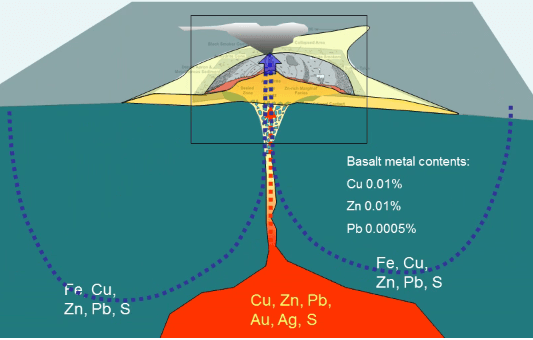 Leaching metals particularly iron there’s also bases metals and sulphur on the volcanic. Metal concentration in the hydrothermal fluids, volcanic and recycled seawater, are really low- just fractions of a percent. So how do we end up with the ore that makes up 20- 30% metal?
Leaching metals particularly iron there’s also bases metals and sulphur on the volcanic. Metal concentration in the hydrothermal fluids, volcanic and recycled seawater, are really low- just fractions of a percent. So how do we end up with the ore that makes up 20- 30% metal?
The next slide will be on the seafloor to explain this. You can see there is a neck of fractured rock below the seafloor caused by the violent boiling of the hot fluids as the pressure is reduced, that in turn is surmounted by a series of chimneys that allow the fluid escape into the cold sea, at the bottom of the thermocline is really very cold, it’s often only a few degrees above freezing even in the tropical areas. Surrounding the chimney is an exhalative length of sulphuric material that forms on the floor. The secret of the high grade of the ore lies in rapid cooling of the hydrothermal fluid when it reaches the full seafloor.
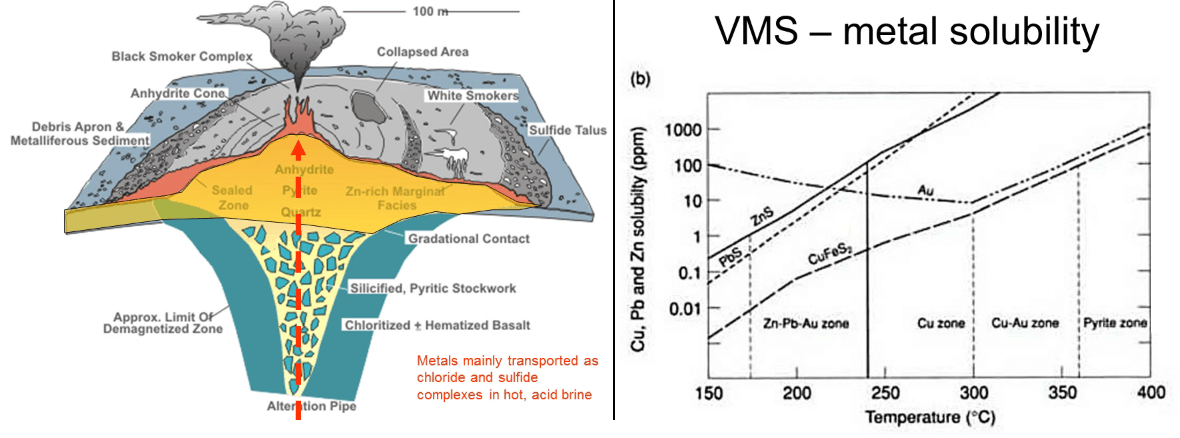 As in porphyry deposits, the main focus of trend in deposits is the drop in temperature rather than changes in EH or pH. Different metal sulphides tend to drop out a metal solution at different temperatures- copper and gold first, followed by zinc, then lead and finally iron. There’s an overlap in the metal deposition, but that’s the broad trend. Copper starts to drop out as the temperature starts to drop from 400 degrees Celsius down to 300 degrees. The Iron and the copper drops out before the fluids actually reach the seafloor. Precipitating is a stockwork of veins in the brecciated funnel also called stringer zone, beneath the sulphide lens.
As in porphyry deposits, the main focus of trend in deposits is the drop in temperature rather than changes in EH or pH. Different metal sulphides tend to drop out a metal solution at different temperatures- copper and gold first, followed by zinc, then lead and finally iron. There’s an overlap in the metal deposition, but that’s the broad trend. Copper starts to drop out as the temperature starts to drop from 400 degrees Celsius down to 300 degrees. The Iron and the copper drops out before the fluids actually reach the seafloor. Precipitating is a stockwork of veins in the brecciated funnel also called stringer zone, beneath the sulphide lens.
The fluids are hot, and because they are from a high sulfidation source, they’re moderately acid. This acidity alters the feldspars and host rocks to clays, some of which are washed out the rock and others metamorphous form sericite mica. Dissolved silica in the hot solutions distributes deposits such as quartz along with iron sulphide. You may hear geologist referring to this characteristic leach quartz, sericite pyrite assemblage the results are either QSP or folic alteration.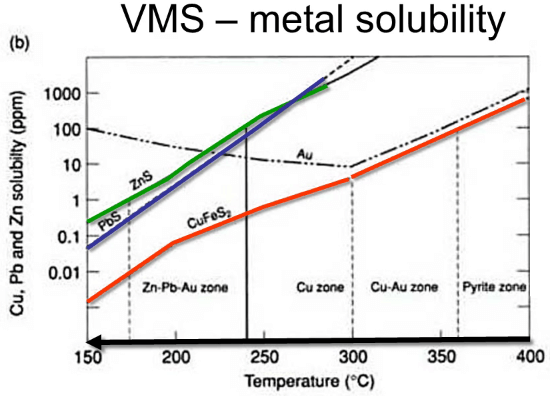
As the hydrothermal fluids reach the cold seawater, the temperature drops within seconds from 300 degrees down to 100 degrees and less. The lead and the zinc sulphite precipitates along with along with the remainder of copper. The sulfides dissolve along the sides and at the top of the vents, extending them and then bellow out to form black and white smoke as you see in National Geographic pictures. The fine clouds of sulphide cool and settles on the seafloor, building up a finely banded layers of pure sulphate which are closest to the vent, galena and sphalerite next. Pyrite deposits throughout the sequence and most desolate from the bed that is the only sphalerite still available to deposit. Beyond that the sulphur is exhausted and iron-oxide or hematite and silica is all that’s left to precipitate.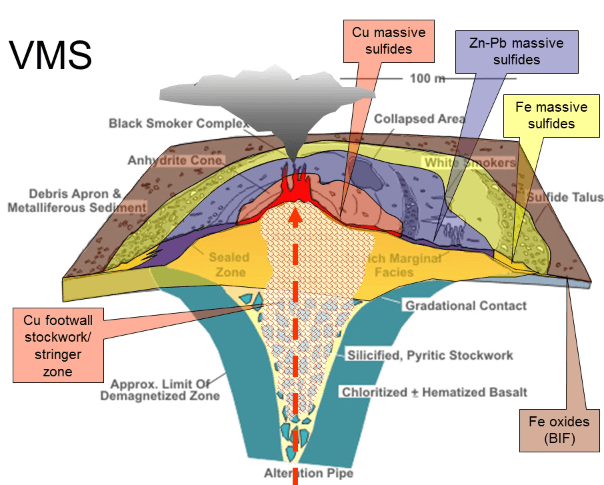
The massive sulphide is made up of a combination of finely interbedded sulphides that settle out of the black smokers and fragments of chimneys that have broken off and rolled down the slope. Here are couple of shots of massive sulphides in outcrop, note the typical, fine rhythmic banding just below the hammer on the left hand photo. The photo in the bottom right shows abandoned iron formation, developed very distantly to a VMS vent, as you can see it is made of hematite or magnetite which is oxide, rather than sulphide and white silica.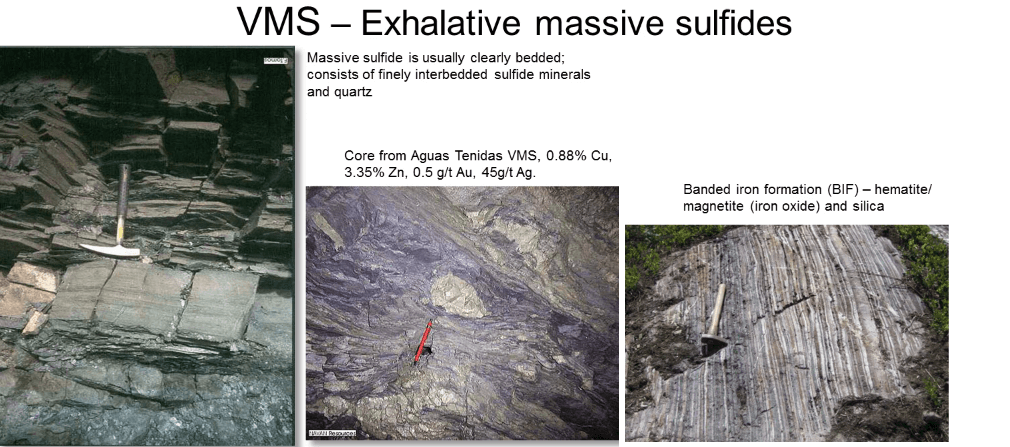
The fluids that form VMS deposits usually reach the seafloor of faults, because those faults represent zones of weakness when the stratigraphy is subsequently subject to deformation, the area around the faults is often particularly deformed. Combine this with the highly ductile nature of massive sulphides, we find that massive sulphide lenses themselves often exhibits extreme deformation. Very often the stringy cap which started off with a very high angle to the massive sulphide mushroom cap, is flattened and rotated to a much more acute angle and the massive sulphide may end up squeezed into a cigar shaped broad.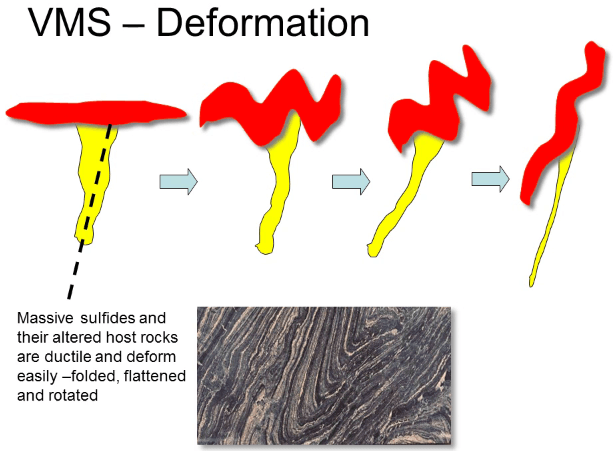
So not we know a little more about how VMS deposits are formed, let’s consider; where they occur; how common they are; and more importantly how big they are and what metal grades can we expect.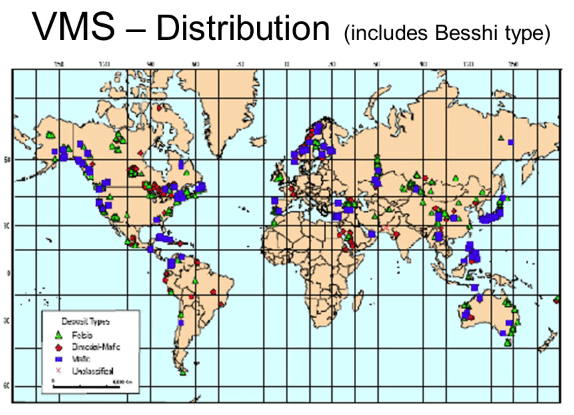
VMS deposits have been forming since the earliest of times in the Earth’s history and they are still forming today on the seafloor. As you might expect, they are found all over the world and in all ages of rocks. However, there are few areas in history where they seem to be particularly prevalent- the late Archean and the Tertiary, seem to be very prolific times. The blue, green and red symbols mark some of the more important VMS deposits worldwide.
Ok, what about size and grade? There are a number of different classes of VMS, each with somewhat very different characteristics.
It’s nice to say that economic VMS deposits generally range in size from 4- 25 million tonnes with an average of about 5 million tonnes, although there are a few monsters such as Peak Creek in Ontario which is 150 million tonnes.
Average Volcanogenic Massive Sulphide Ore Deposits Grades:
- 5% copper
- 4% zinc
- < 1% lead
- Maybe 1 gram per tonne of gold.
Again there are a few outlines with far higher grades than these.
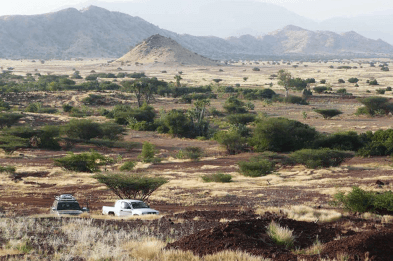 Let’s look now at a few examples of VMS deposits. Nevsun’s Bisha deposit near Eritrea is a superb example of a VMS deposit.
Let’s look now at a few examples of VMS deposits. Nevsun’s Bisha deposit near Eritrea is a superb example of a VMS deposit.
It was discovered in January in 2003, construction began in 2008 and production in 2011. This is a view of the Bisha deposit looking south, before development began. The dark brown material in the foreground is a zinc rich deposit the without the outcrop of the mineralization. Not surprisingly, the way the mineralization is being folded and it plunges to the south, where the stringer zone smeared out, parallel to the massive sulphides. The massive sulphide material varies from 1- 70 meters thick, this is unusual as most VMS deposits are less than 20 meters in thickness. Bisha is a footprint that’s about 1 kilometre long and 200 meters wide. In spite of the steep dip to the mineralization which results in a pit with a high stripping ratio the deposit has one big advantage. So there is a leach gold zone on the surface, underlain by a secondary enrich copper zone with the primary zinc dominated, primary zone below that.
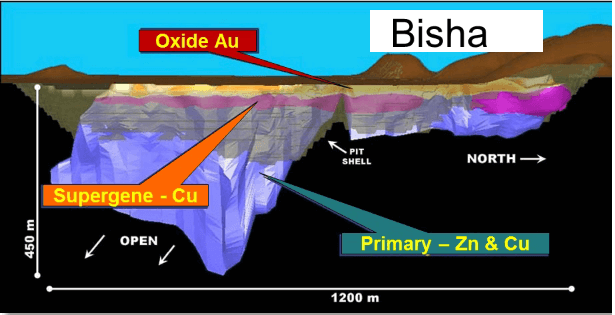 The advantage of this is the expense is concentrated and does not have to be booked by start-up and could be constructed just a few years later when the primary sulphides are reached and funded, most importantly from cash flow, rather than debt. Most attractive of all in Bisha, is the size:
The advantage of this is the expense is concentrated and does not have to be booked by start-up and could be constructed just a few years later when the primary sulphides are reached and funded, most importantly from cash flow, rather than debt. Most attractive of all in Bisha, is the size:
- With reserves of 26 million tonnes
- at 1.8% copper
- 6.3% zinc
- 0.9 grams per tonne gold
- and 41 grams per tonne silver.
This is 5 times the average VMS site. VMS deposits occur in clusters/groups and Bisha is no exception. With at least 7 other VMS deposits discovered within 20 kilometres. Although Bisha is the only one in production so far.
The second example we are going to talk about today is kind of unusual, it’s actually a group of deposits that only recently been formed, in fact they are so young they are still on the ocean floor and will have to be mined remotely from floating platforms. They were discovered by Nautilus Mining Company using a combination of both metrics and EM geophysics. To date it gives and fascinating insight to the nature of the black smoker fields.  This image is taken from Nautilus’ 43 101 report and it shows an amazing isometric view of the chimney of Salwara 1 target off the coast of Papua New Guinea derived from the symmetry.The image covers about 800 meters from left to right and the individual chimneys are clearly visible. The small image shows remote operating vehicles claws, removing a sample of a smoker chimney for for assay. For environmental reasons only extinct smokers were targeted. Once the hot water stop flowing, the cold and lack of nutrients causes the once abundant sea life to move away or to die. Extinct smokers are therefore devoid of significant sea life, and environmentally not an issue.
This image is taken from Nautilus’ 43 101 report and it shows an amazing isometric view of the chimney of Salwara 1 target off the coast of Papua New Guinea derived from the symmetry.The image covers about 800 meters from left to right and the individual chimneys are clearly visible. The small image shows remote operating vehicles claws, removing a sample of a smoker chimney for for assay. For environmental reasons only extinct smokers were targeted. Once the hot water stop flowing, the cold and lack of nutrients causes the once abundant sea life to move away or to die. Extinct smokers are therefore devoid of significant sea life, and environmentally not an issue. 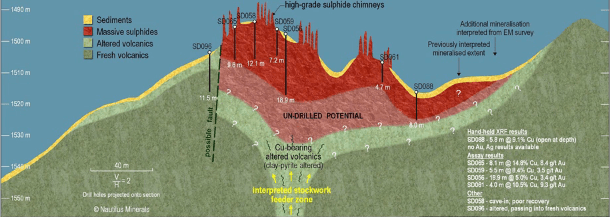 In the cross section of the Solwara 1 VMS based on mapping and drilling of deposits we can see the massive sulphides in red, the alterations associated with stringer zones in pale green. Although the resource is relatively small, just two and a half million tonnes, the grades are exceptionally high- with a copper grade of almost 8% and a gold grade of over 6 grams per tonne, as is typical there has been at least 18 other deposits discovered in this particular cluster.
In the cross section of the Solwara 1 VMS based on mapping and drilling of deposits we can see the massive sulphides in red, the alterations associated with stringer zones in pale green. Although the resource is relatively small, just two and a half million tonnes, the grades are exceptionally high- with a copper grade of almost 8% and a gold grade of over 6 grams per tonne, as is typical there has been at least 18 other deposits discovered in this particular cluster. 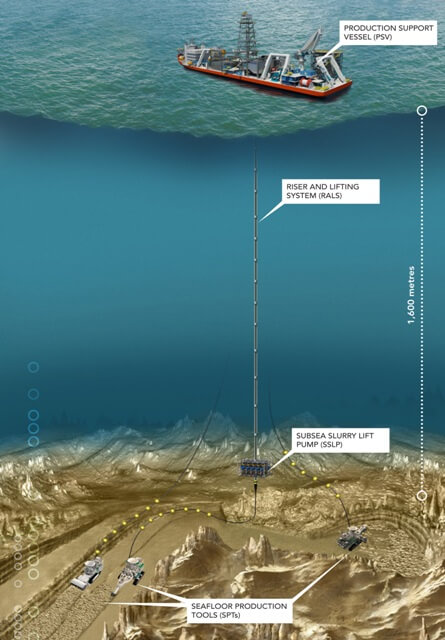 The Solwara 1 VMS is at a depth, 1600 meters below sea level. Submarine VMS deposits have never been mined before but the equipment that Nautilus plants use has a proven record, excavating trenches for submarine cables and mining marine diamonds off the South African coast. Its practicality is well established. This is another piece of mining equipment that Nautilus is considering having custom built, you will notice the proposed completion date in this old material, to my knowledge this construction is still on hold which gives the indication that funding and mining will not be straight forward. Once the material is remotely mined, its plan to pump it to the surface as a slurry then to transfer debarked or to transport to lower a sure base concentrator.
The Solwara 1 VMS is at a depth, 1600 meters below sea level. Submarine VMS deposits have never been mined before but the equipment that Nautilus plants use has a proven record, excavating trenches for submarine cables and mining marine diamonds off the South African coast. Its practicality is well established. This is another piece of mining equipment that Nautilus is considering having custom built, you will notice the proposed completion date in this old material, to my knowledge this construction is still on hold which gives the indication that funding and mining will not be straight forward. Once the material is remotely mined, its plan to pump it to the surface as a slurry then to transfer debarked or to transport to lower a sure base concentrator.
Also see another worthwhile resource https://sites.google.com/site/ctbageoconsultants/

